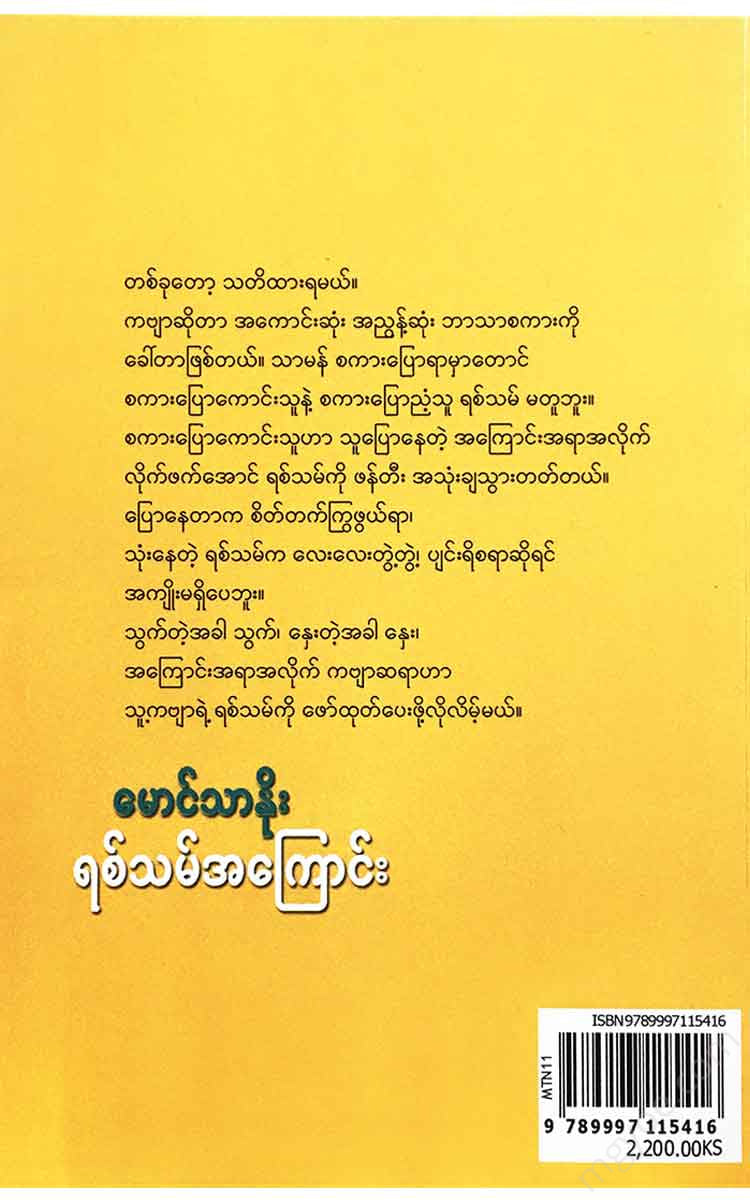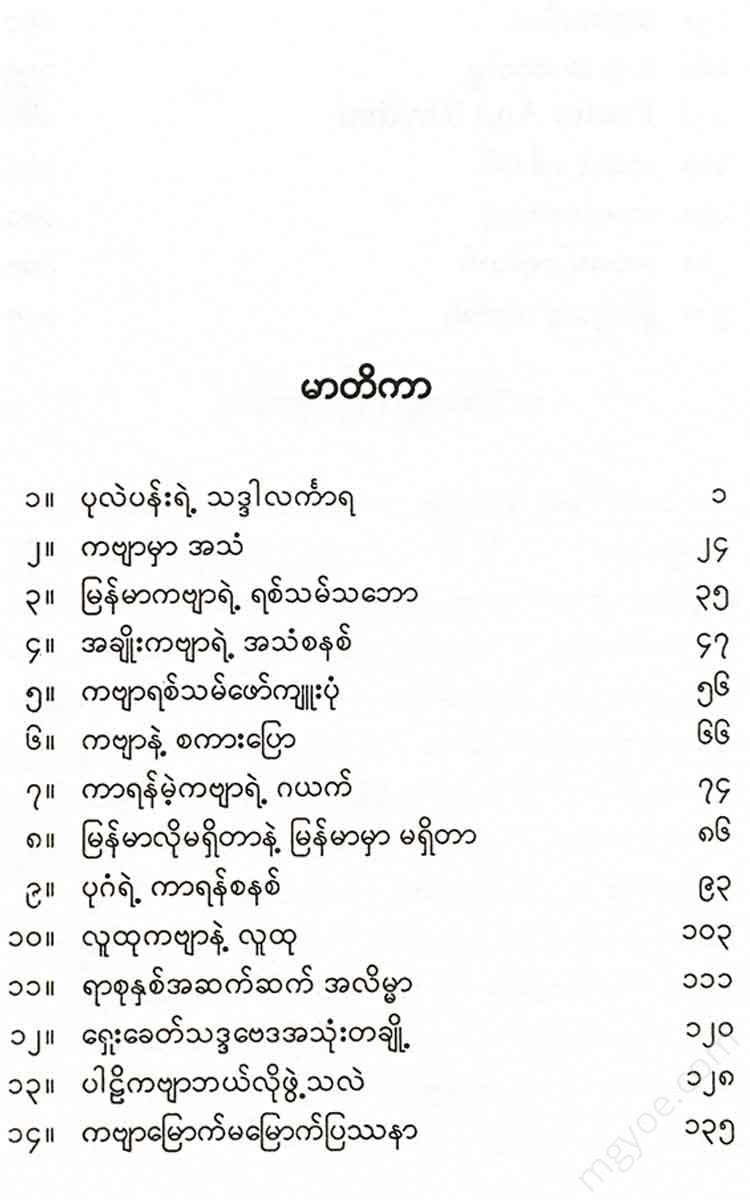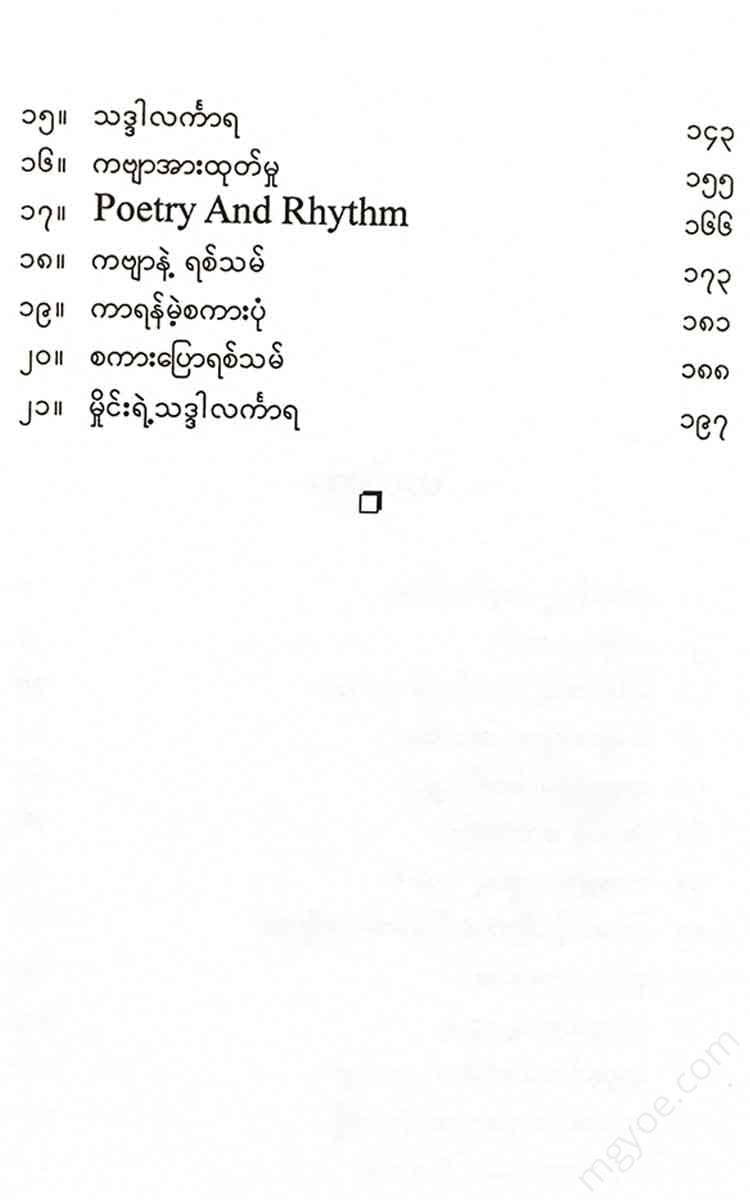စိတ်ကူးချိုချိုစာပေ
Maung Thano - About Ramtham
Maung Thano - About Ramtham
Couldn't load pickup availability
When we were young, my father used to recite the Buddhist scriptures every night, such as “Parami” and “Koh Khan” that he had memorized, and he would recite them in a regular tone. When I was young, I didn’t know what they meant. I thought they were good to listen to. So we got used to hearing “Jatipunya Gammonma” and all the things that were said in the past. I didn’t have to sing and draw and draw like some Buddhist scriptures, but I realized that just by reciting them regularly, there was a certain taste in the music.
Now that I'm older, I often wonder why these poems are so appealing to the ear.
To understand the point I want to make, you need to read aloud a verse from the Maharashtrian epic, the Nine Chapters. (You should read it as you normally would. Don't do anything like "Shwe Mann Tin Maung Mae Za Taung Chee.") But you should read it slowly, carefully, clearly, and accurately, not like a child who is just starting to read.
Burmese poetry is based on rhyme. So we used to think that Burmese poetry does not have a sound system like poetry in other religions. But since poetry originates from music, it is impossible to write poetry without using sound as a model. Some of us young people often criticize the way we compose poetry and say that it is “cornered”, right?
The sound system in Burmese poetry is not obvious if you study the four-syllable rhymes. It becomes more apparent when you try the two-syllable and four-syllable rhymes.
Please, please.
Golden yellow mountain oil
This guy brought it.
If this were an attempt to combine two- and four-line stanzas, anyone familiar with poetry would immediately criticize it as "sounding like something." Compare it to the poem below and read it.
Pan is Pan.
On the Golden Mountain
Come pick flowers.
Here, it's not a corner. It's a mess to read. It's smooth. To put it in technical terms, the low and high tones are even. It's called rhythm. If you examine it, you'll see that the small letters အမှင်,
In many European languages, such as English, the rhythm of poetry is determined by the accent or stress. In Pali, Sanskrit, and Latin, the length of the vowel is determined by the vowel sound. In Chinese, it is determined by the tone. Since Myanmar is a tone-based language like China, the tone system must be determined by the tone.
In Burmese, vowels have three different sounds in a vowel. The vowel A has three sounds: A, A, A, and A, and the vowel Ee has three sounds: Ee, Ee, and Ee. We call this tone. There are three tones in Burmese. (Many teachers still say there are four. The sounds that are pronounced with the vowels A, A, and Ee are considered the fourth tone. We will consider them to be the same tone as A, Ee, and U.) Of these three, tone 2 is the level tone, and 1 and 2 are the falling tones. The falling tone is considered the regular tone, and the falling tones are considered the deflected tone. The alternating between the regular tone and the deflected tone is the basis of the rhythm of Burmese poetry.
If we were to mark the right iron with a (b) symbol and the wrong iron with a (-) symbol, it would look like this.
With the pride of a native Punya .- .- ..--
The most beautiful and beautiful woman in the world. . - - • - -
Four types of three-pointed swords • - , - - • - .
The flag of the city is strong and strong. • -•• -• • •
Here, it is important to note that although the 1st and 3rd tones are pronounced, when compared to the 3rd, the 1st tone is weakened. Therefore, the correct tone should be considered. If there are only 3rd tones, two or three, only the tone that rhymes is considered pronounced. The “ta” in “ສານສັກກັກກັກກັກກັກກັກກັກກັກກັກກັກກັກກັກທະນາ
If you look at the poems of Maharashtrians, you will see that they alternate between regular and irregular tones to create rhythm. Sometimes they use one tone, sometimes two tones. In Myanmar, a four-syllable verse is said to have a harmonious sound if at least one of the four tones is used.
In Burmese poetry, the sound system is the only thing that speaks to the rhyme scheme. For someone who is not an expert in poetry, they tend to pick rhymes at random, without giving priority to the sound, but someone who is versed in poetry usually decides on the rhyme scheme and prepares it. For example:
With the pride of a native Punya
A full-bodied, unctuous, and unctuous man.
In this three-paradise group, the rhymes are မှ, မှ, မှ. မှင်းမှင်း. Each of them has its own unique sound in its own pada. Similarly, after taking only the 1st tone, in the second group of rhymes, Sayadaw Ratthasahara took 3 more resonant tones (မှင်း, မှင်း, မှင်း). And then he took the same way. (မှ, မှ, မှ) The sounds seemed to become more resonant step by step. At this time, Sayadaw relaxed the sound in the next group. He cut a group of sounds with the words မှင်း, မှင်း, မှင်း. Then he took it again with the 3 tones မှင်း, မှင်း. In this way, Sayadaw took the rhymes like large waves rolling, rising, falling, rising. In the momentum of the sound waves of this rhyme, we, the readers and listeners, are mesmerized and begin to follow.
So, it must be said that in composing classical Burmese poetry, the poet paid attention to three points.
(1) It connects with each other through rhyme.
(2) The rhyme groups that are taken are also made into a single round of gongs and a single round of gongs.
(3) In every line, at least one of the consonants is included as a consonant. The rhythm of the poem in these three "chapaings" is smooth. If you study the nine-line poem of the poet Ratthasahara, you can see that this pattern is the same.
That time, compare
For example, Kawkanuda ( Kyaw-Thaw-Kaw, Thanpyay)
Kyaw Saw Hla Thar
Poppa Padon (D-Hlafa, Thanja)
If you are a turtle,
The cloud cover (the cloud cover, the sky)
Ravi Tunmu
Spreading fragrance (ton-ton-moon, thanjjat)
Beautifully descended
The thin line (the thin line, the thin line)
Note that in a group of three verses that are rhymed with a rhyme, each verse contains a single consonant as the main consonant. For example, in “पमा तोव का” the consonant is “का” and in “क्रा पुत तुरी�
This rhythm of the sound rising and falling, rising and falling, is the regular rhythm. The poet often adds small changes to prevent it from getting too long. In the first stanza of the nine-chapter poem, “Jatipunya,” Sayadaw Ratthasara used the rhyme pattern as he said. When there were eight rhyme groups and 17 verses in a row, he changed the rhyme pattern from 4-3-2 to 4-1, changed it to 3-2 once, and then continued with the usual 4-3-2. So when there were seven rhyme groups and 14 verses, he added three 4-2 rhymes in a row. Then he continued with 4-3-2 until the end. An African drummer plays a piece regularly, and after a while, he plays it briskly, then he plays it regularly, and plays it hard for a long time.
The poet does not only express the meaning he wants to convey through the words, but also through metaphors and similes, but also through the sound of the words. Only then can the meaning of what is being said be more powerful. That is what makes the poem good. A good poet only relies on beautiful words, and the better the poet, the more he uses sound.
Repeatedly, one birth, one foot.
A little bit of a bad thing
A little bit of a longing, a little bit of a longing
Yawning, hehe, clinging
The tatar is sobbing and moaning.
A tree and flowers spread out around it.
To the arahant
The cycle of the poem is famous. In this poem, the monk has used a dynamic rhyme system of 4-2. In terms of sound, he has used the form of “...” or “...” and has alternated it quickly to create a spinning wheel. You will find many examples of this rhythm in the monk’s works, using it to express his own meaning, either quickly or slowly. Just look at this verse.
Shin Mon, walk slowly and quietly.
It's not going to get better, it's just giving up.
Don't turn around, just go straight ahead.
Look, Yuga Mat is straight.
The waiting is a time of self-control, a time of rest.
This verse, like the previous verse, uses the 4-2 rhyme scheme. But at the end, there are 4-3-1 once, 4-1 twice. The sound system is also made with at least two accents in each verse, such as “---1--”. So, instead of being as fast as a spinning wheel, it seems to move slowly and steadily. From “Shin Mon Pi” to “Ma Ko Ma Thar”, both the rhyme and the sound are shown to move steadily and steadily. The 4-2 rhyme scheme and the -.-.” sound system are used to express this. After that, the rhyme scheme changes to 4-3-1, which is a reinforcement to keep the pace from increasing. After this, the use of a weak rhyme scheme and the change of sound system to “--” also makes the regular and steady movement stronger.
The monk describes the feeling of wealth in verse 22 of the Lankan hymn.
Don't fall, don't fall • - • -
Ma soe ma ream (when compared with the consonant “ma”, the consonant “ream” becomes .-.-)
To the wealth of the gods
- - -
The sound quality is such that it conveys the feeling of being in a state of bliss, without any pain or discomfort, and the sound quality is so good.
Verse 9 of the Lanka Poem is where the priest Panna scolds the Nyaungpinn Nata for not allowing the king to have a son. The monk composed this verse to sound like the kind of scolding we hear in our plays.
People often don't know the good or the bad.
Wait for the Lord.
We are the ones who bought the land.
What is it that you need?
Are you sad?
Wealth is not a bad thing.









